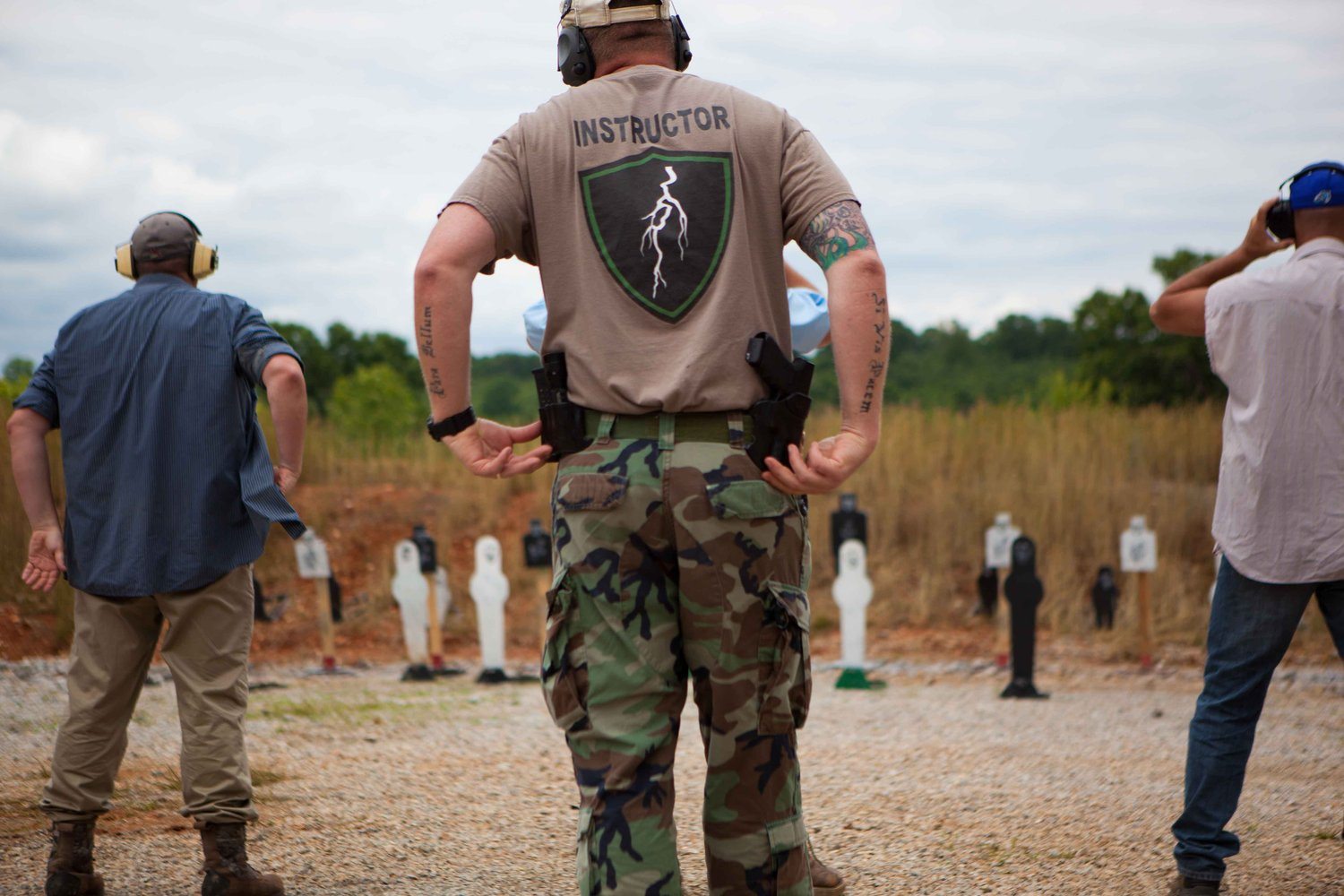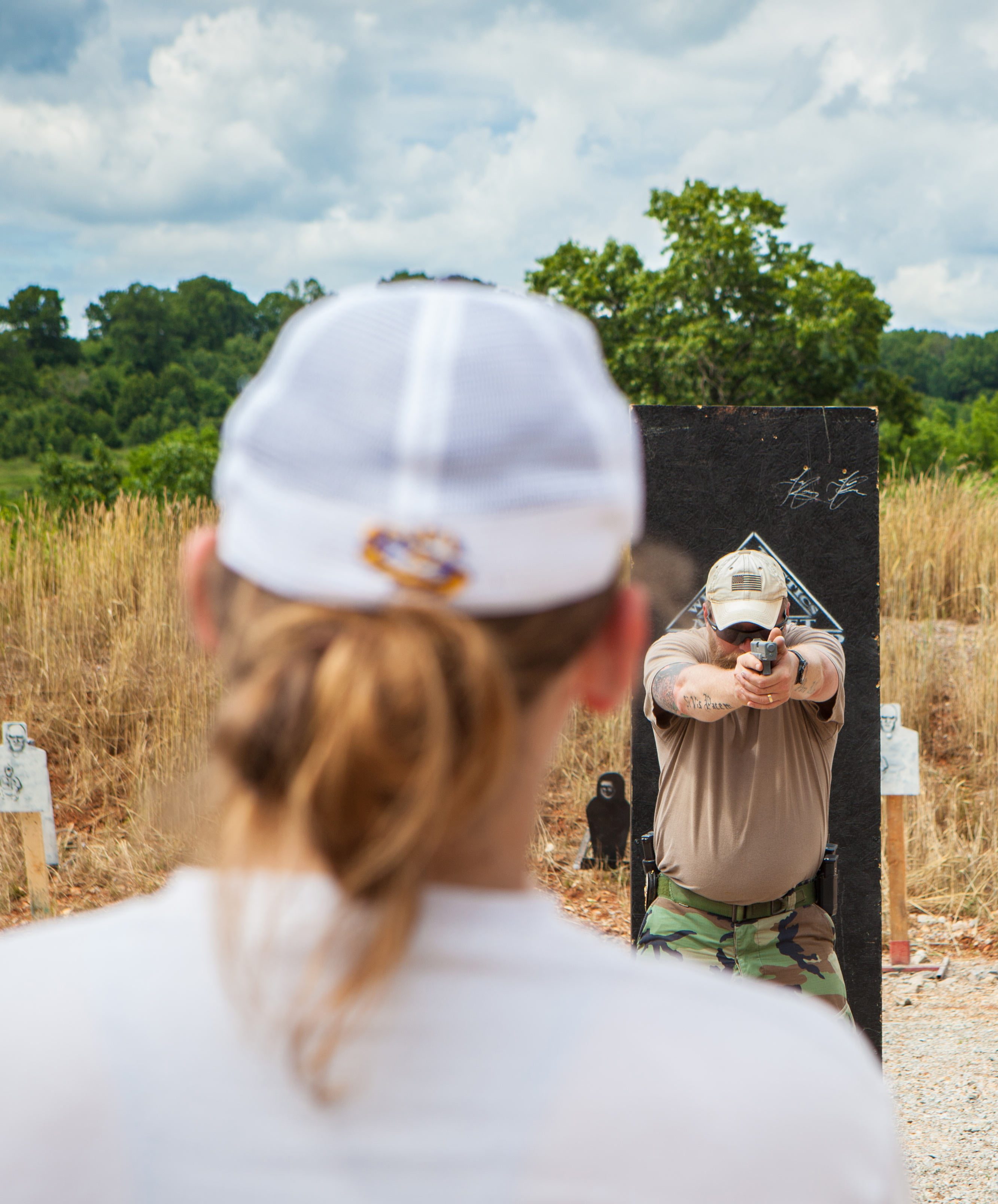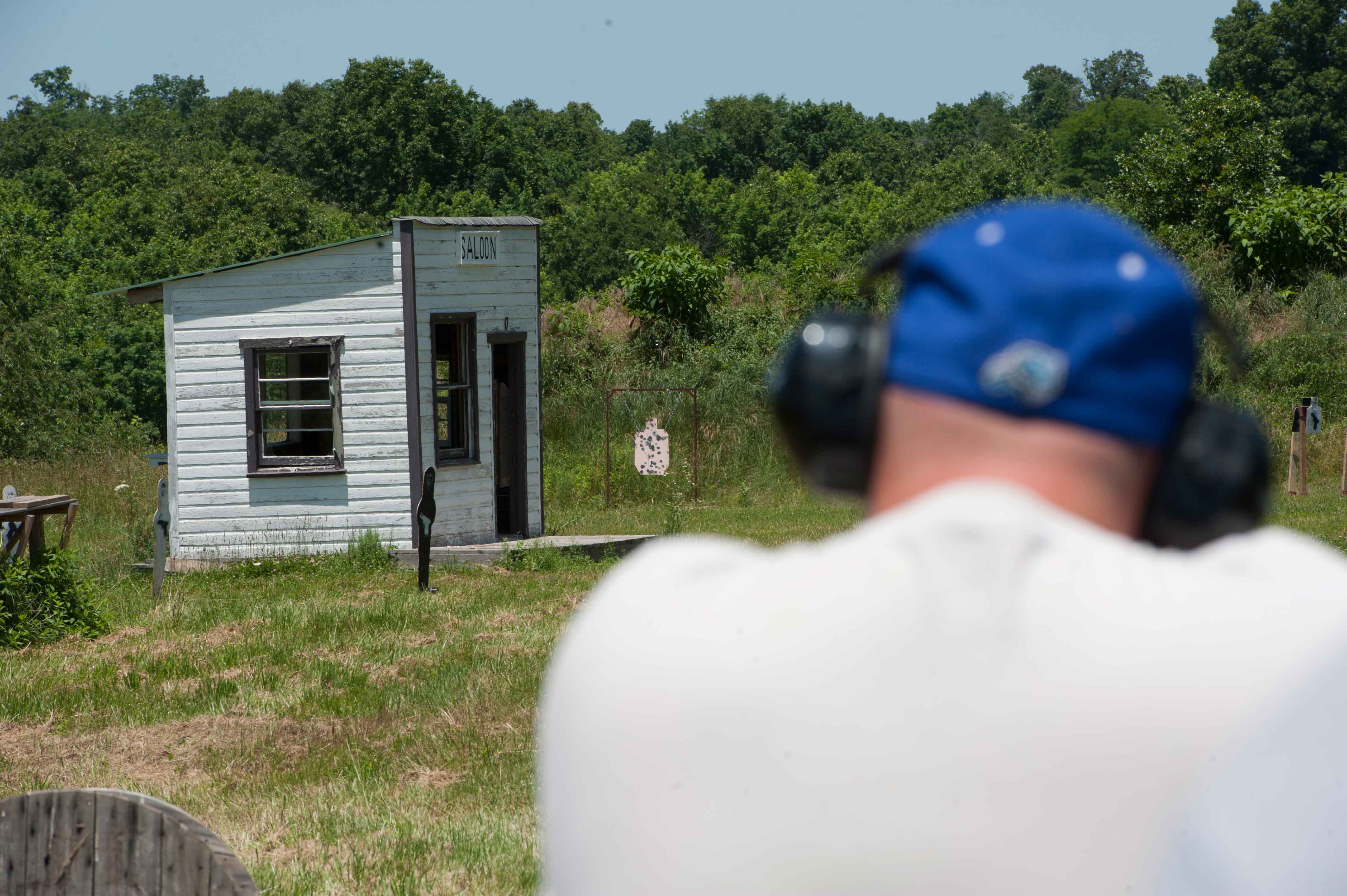This story appeared in the October 2014 issue of Missouri Life.
Three nooses hang limply from the gallows on the north side of the field. The adjacent saloon is empty.
The early afternoon summer sun bakes the rolling Ozark hills near West Plains. There are ticks in the tall grass, and just moments earlier, someone almost stepped on a snake.
Daisy peers through her aviator sunglasses, assessing the scene. Multiple bad guys. Some innocents, too. She must be precise when she engages the targets. So much pressure. Remember the training. Remember the fundamentals.
Stance: Feet are shoulder-width apart, non-dominant foot should be two inches behind the other. Lean forward “nose over toes,” push the gun toward the target, and roll and lock the elbows.
Grip: Sixty/forty—sixty percent of the grip strength comes from the support hand and forty percent from the gun hand. If you grip too tightly with your gun-hand, you’ll miss to the left. Your thumbs should rest on the left side of the pistol, aligning with the barrel, pointing toward the target.
Sight Alignment: Focus on the front sight at the tip of the barrel. The white dot on the front sight should be centered vertically between the notch in the aft sight; the top of the front sight should be parallel with the top of the aft sight.
Sight Picture: Focus. Your vision might blur; it’s okay if the target seems fuzzy, as long as you can clearly see the white dot. Try not to shake. Breathe.
Trigger Press: Stage the Glock before firing. When you’re ready, put your finger on the trigger. Bring it back slowly—even more slowly. Slow is smooth; smooth is fast. Feel the click as you deactivate the gun’s final safety mechanism. Now you have a hot weapon. Keep breathing.
Continue to inch that trigger back. Pull slowly. You’ll feel pressure build in the trigger. Resistance. The weapon is staged. But slow down! Don’t anticipate the shot. If you do, you’ll slap the trigger and miss.
Constant … steady … pressure. Control that trigger.
BANG! A round downrange.
Don’t let your finger fly off the trigger; ease it out until you feel the click. You’ve reset the weapon. The trigger is staged. A shorter trigger pull now, a faster rate of fire. But take it slowly. Don’t anticipate. Fire again. BANG!
Repeat. BANG-BANG-BANG!
Flipping the Switch
Protection. Deterrence. Mitigation. That’s what Daisy, an elementary school teacher, and ten fellow Missouri public school employees studied in West Plains on June 9-13 at Shield Solutions’ School Employee Firearm Training Program, or SEFTP. The course teaches educators to be “gunfighters”—as Shield instructors call them—who will carry and employ concealed handguns to counter a lethal threat at their schools.
Shield’s SEFTP is a week-long shooting-intensive course where educators train with a Glock 9mm pistol. If they pass, they must return for three annual training sessions, a total of twenty-four hours of additional training.
Make no mistake: the program trains teachers to become warriors. The warrior mind-set—the necessity of “flipping the switch”—comes up often. As Shield lead instructor Don Crowley told the trainees, “Your job is to be a caring, loving, nurturing educator—until that first shot goes off.”
Hopefully, that will never happen. If a shooter enters their schools, Daisy and her fellow educators from four rural districts—Climax Springs, Dora, Lutie, and Warsaw—say they are ready and capable of mitigating the attack and able to balance the roles of educator and gunfighter.
They are teachers and coaches and principals, transportation and maintenance coordinators, bookkeepers, and superintendents. They are young and middle-aged, ranging from twenty-nine to fifty-seven years old. Some are fit. Others carry a few extra pounds. A few smoke, and a few dip. One has diabetes. Another is a former quarterback. Some of them farm or work side jobs.
Most have grown up around guns, using them for hunting and farming. They’ve all fired rifles or shotguns for at least six years. Nine of the eleven educators have been using guns for two decades or more.
However, they have less experience with the Glock 9mm pistol, the weapon they’ll carry in their classrooms. Some have been firing the Glock for a year or two; four of them learned how to use the gun on the first day of training. Daisy has had her Glock for three months. She received her concealed-carry permit through another Shield course, but that course wasn’t intense like the SEFTP. Her shot hasn’t been consistent this week. The reporters and photographers have added stress.
At home, she’s practiced dry-firing her gun, staging the unloaded weapon with smooth trigger pulls. Her child practices with her, imitating her movements with a yellow Nerf gun. She’s taught him about gun safety.
The educators volunteered for this duty, and most of them paid for the Glocks out of their own pockets. They’ve undergone mental health evaluations and random drug tests. They are all parents; five of them have children in the schools into which they will carry their Glocks.
Daisy is a false name. Their true identities are known only to each other, Shield Solutions, and local principals, superintendents, and law enforcement agencies. The educators sign a contract with Shield that mandates this secrecy. The presumption is that schools with a Shield logo on the door will deter an attacker because he or she won’t know who—or how many—armed school employees will rush to neutralize a threat. Confidentiality is for the educators’ protection, lest they become a known target like a school resource officer. Trainees take the burden of secrecy seriously, and it’s a safeguard they demand. They gave me their real names and where they work, but I can’t share that with you. The price of three days of access to these educators and their firearms training is measured in pseudonyms and vague descriptors.
To talk to these educators, to see them in action, is to understand the effect of Sandy Hook on them, to understand the media effect of school shootings that happen “once a week,” as President Barrack Obama said in a June 10 interview with Tumblr CEO David Karp—perhaps a misleading statement depending on how you define “school shooting.” Regardless, it’s not just the media effect that motivates these educators.
After the June 10, 2014, shooting at Reynolds High School in Oregon, a figure spread online: seventy-four school shootings nationwide had occurred since the December 14, 2012, incident at Sandy Hook Elementary. Everytown for Gun Safety, a gun control advocacy group, supplied that number. Politifact.com, an independent fact-checking news organization, analyzed those seventy-four shootings and concluded that a broad definition of “school shooting” is necessary to classify each instance as such.
- 10 shootings mirrored those at Columbine and Sandy Hook where “a shooter intended to commit mass murder.”
- 39 were related to “criminal activity or personal altercations.”
- 16 had no connection to school members and occurred outside of the school day.
- 6 were suicides.
- 3 were accidental discharges.
- 2 were in Missouri.
A trainee sits on an old church pew on the bunkhouse deck at Twin Bridges Canoe and Campground after a day of training; she sips a Bud Light and cleans her Glock by the porch light. Educators ask questions about state statutes, grappling with the legal liability they will incur. Daisy winces in pain when a hot spent shell casing lands in the frame of her sunglasses.
The educators say that they hope to never pull their guns or engage an active shooter, especially if it were one of their own students. They espouse confidence in their training, uttering variations of the phrase, “This is the best way to give our students a fighting chance.”
And listen more closely when they ask you—in front of the entire group—if you believe in what they’re doing, if you agree that arming educators is the most effective way to lessen the loss of life should violence darken the schoolhouse doors. Have Daisy ask you this question on the heels of the June 10 shooting at Reynolds High School in Oregon, which followed the May 24 Santa Barbara shooting and stabbing spree. Surely, they say, you can understand why we would consider arming teachers
—especially in rural school districts where law enforcement response times might quadruple the time you wait in the McDonald’s drive-thru.
It took Adam Lanza about ten minutes to breach Sandy Hook’s locked doors and kill twenty-six people. And that was with adequate police response time. These educators will tell you that those kids didn’t have a chance.
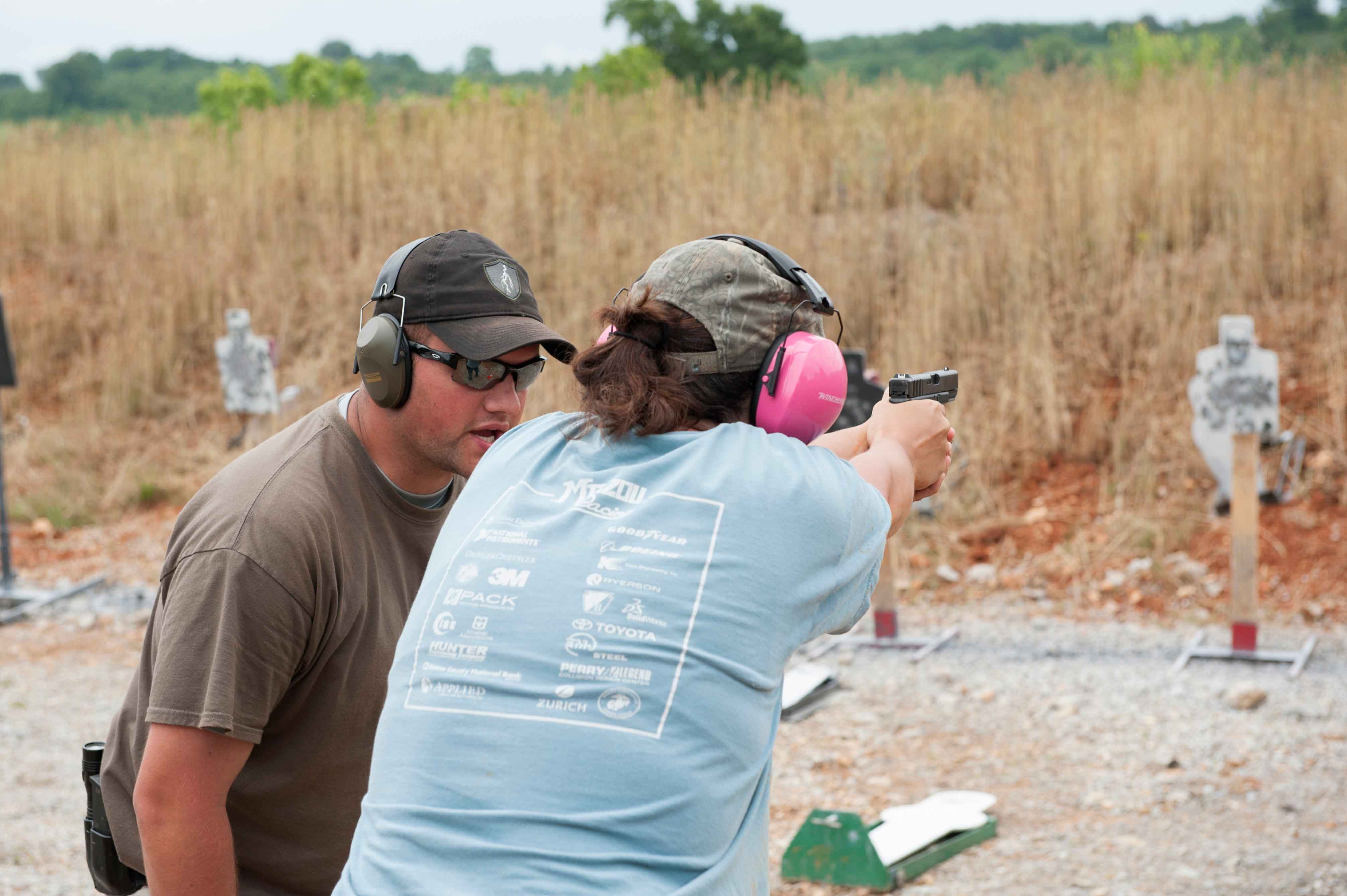
The Genesis of Shield
Prior to Sandy Hook, Robbie Crites, a member of the Fairview R-XI School District in West Plains and former Howell County Sheriff, was aware of the lengthy response times in his district. In theory, those times seemed adequate. A Howell County deputy could be at Fairview Elementary in fifteen to twenty minutes. The West Plains Police Department could manage a similar time. On a good day, depending where officers were patrolling in the county, the response time could be four or five minutes. However, there are many variables.
At 928 square miles, Howell County is Missouri’s fourth-largest county. Rural and winding roads cut through conservation areas and the Mark Twain National Forest. The sheriff’s department employs eleven full-time patrol deputies; the West Plains Police Department employs twenty-eight full-time officers. Together, they cover the county’s schools, although not all are on duty at the same time. Depending where officers are at the time of a call, response times could reach up to a half-hour.
In November of 2012, Robbie and other members of the school board discussed acquiring a school resource officer but determined that their funds could be better allocated. Also, they believed if they requested an officer, other schools might do so, which would put a burden on the police force. Additional physical security features—such as more cameras, a security foyer, and exterior door access systems—were also expensive. They needed a cost-effective, quick-response safety plan.
Robbie knew Greg Martin, a local former Missouri State Highway Patrolman, who had a private investigations and security firm, G.R. Martin & Associates. In fact, G.R. Martin had provided private security for Fairview after the school fired a disgruntled employee. Greg personally delivered the termination paperwork.
Robbie asked Greg if it would be possible to train a school employee as a security officer through a rigorous firearms training course. Greg was intrigued. He contacted Don Crowley, a trained sniper and former police chief of Winona who has authored numerous Peace Officers Standards and Training (POST) firearms courses. Don and his company, Defensive Engagement Concepts, could facilitate the training. The conversation between Robbie, Greg, and Don continued through November and into December. It escalated after the Sandy Hook tragedy on December 14, 2012.
Fairview had to work with the Missouri United School Insurance Council, or MUSIC, to ensure it didn’t violate the terms of its insurance policy. The agreement was that MUSIC would continue to insure Fairview if another entity picked up the school’s primary liability insurance regarding incidents with armed teachers.
And so Shield Solutions was born as a stand-alone company in February of 2013, created to shoulder the $3 million liability insurance burden necessary for Fairview Elementary to arm staff members and to divorce parent company G.R. Martin & Associates from any liability.
By March of 2013, select Fairview employees had passed Shield’s SEFTP and were carrying concealed weapons in the school, according to a letter the school sent home to parents. Greg thought the Fairview deal would be a one-time gig. But other rural school districts, like Daisy’s, learned of the program.
As of September 2014, Shield has trained thirty active school employees from twelve different campuses. Shield charges schools $17,500 to train two staff members, which includes all costs for the program. Insurance is the program’s biggest operating cost, though each class costs the company around $10,000 in ammo alone.
As lead instructor for the SEFTP, Don has been spending a lot of time on Shield’s Alpha and Bravo firing ranges.
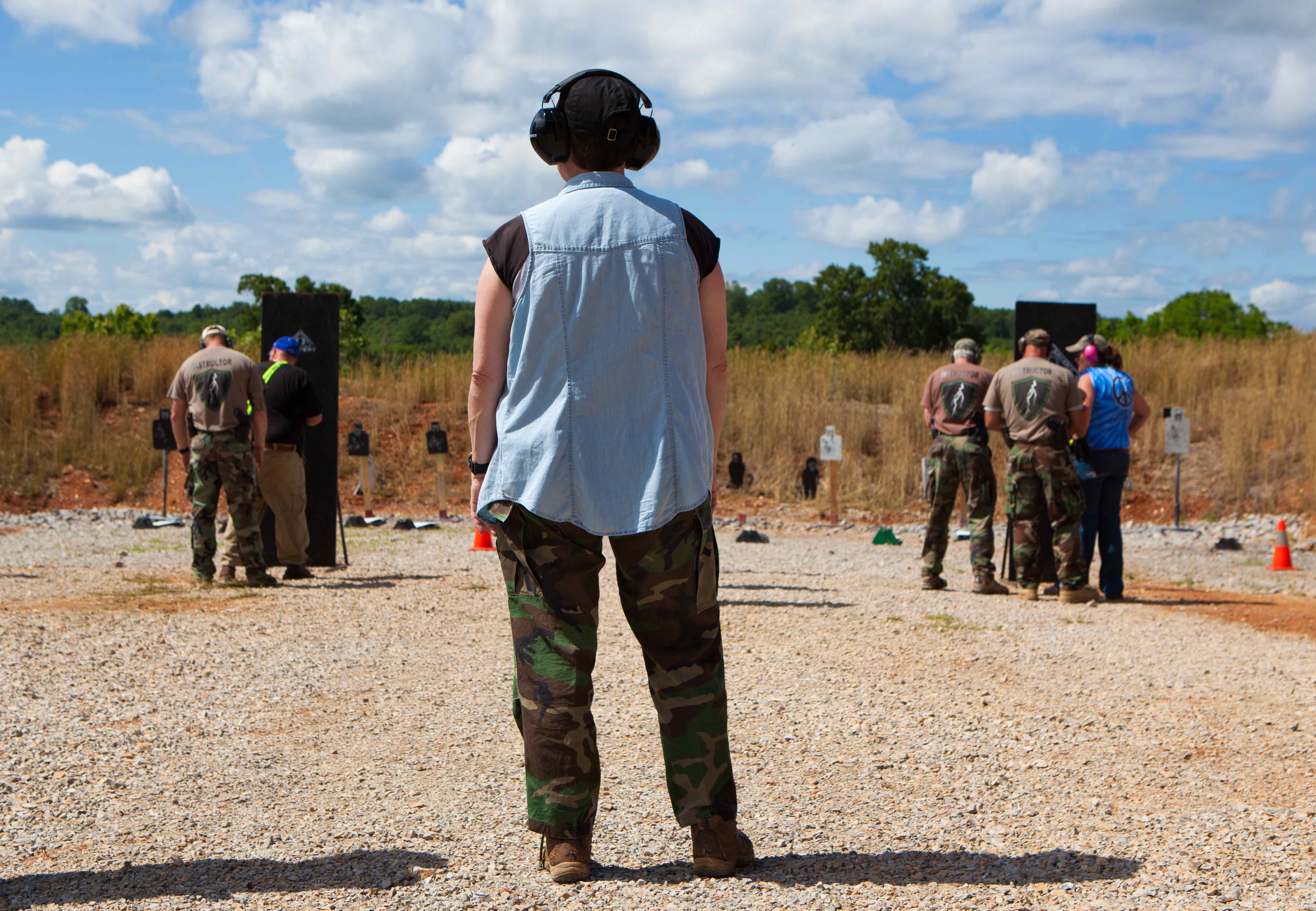
Back-Slappers and Back-Breakers
Don Crowley is built like two beer kegs stacked atop each other. As he paces the firing line at Shield’s Bravo Range on the third day of training, he looks the part of a special operator. He wears desert-brown combat boots and camouflage cargo pants, held up at the waist by a tactical belt replete with gun holster and slots for ammo magazines. (They’re magazines, not “clips.” Those are what girls wear in their hair, Don will remind you.)
His drab, olive T-shirt with a large Shield logo, a lightning bolt within a black shield, is always tucked in. He wears a baseball cap that sports a tan-and-brown American flag. A long dusty-red beard streaked with gray frames his mouth that’s often smoking a Marlboro cigarette. His facial hair creeps past Oakley wraparound sunglasses and up to his closely cropped hair.
Minus the facial hair and the cigarette, this is the standard uniform of a Shield instructor. In addition to Don, there are four others: Derek “Smiley” Hughston, Jason Long, Fred “Daddy” Long, and Rob “Pilk” Pilkington. They work as a team, five fingers on a hand that will pat you on the back and punch you—figuratively—in the gut.
They are thorough, sometimes training a student one-on-one on an adjacent range. They are safe. They are coordinated. They communicate without speaking and monitor the firing line. They’ll pull a student back by his shirttail if he might step into another trainee’s field of fire. They are critics, chastisers, and cheerleaders. They are back-slappers and back-breakers.
Derek is the youngest. His pearly white smile is offset by a river runner’s tan. He rarely yells, but he will get in a trainee’s ear, delivering advice like a player’s coach. He’s also a member of the Howell County Sheriff Department’s tactical team.
Jason is the shortest of the bunch. His body is coiled tightly like a spring, his posture upright, his gait precise when he walks downrange. The Army veteran leads the Howell County Sheriff Department’s tactical team and, aside from Don, is most likely to get in your face and raise his voice. He’s an affable guy—and Shield’s best shot.
Jason’s father, Fred, is the oldest trainer at sixty-two, but he’s more agile than most thirty-year-olds. He’ll draw his pistol, steady his aim, and calmly put his first round through a 32-by-18-inch target from a hundred yards out. A former Army paratrooper, he made the final jump of his career on a Friday the thirteenth. Fred has a soft voice and a pleasant grin. He often wears a shemagh—a desert scarf and head-wrap—around his neck.
At six-foot, two-inches tall, Rob, the resident medical expert and a walking “attaboy,” is a big man. The Navy veteran’s eyes light up after you’ve submerged your arms for sixty seconds in a vat of freezing water—diminishing your dexterity—and then successfully put a tourniquet on your partner. He’s happy that you’ve fallen back on your gross motor skills training in the face of your body’s fight-or-flight reaction. He’ll flash you a goofy, gung-ho smile.
Don is the largest presence—in any sense. If there’s a photo of the instructors, the former Army airborne-qualified recon-specialist is usually in the center. He’s the leader out on the range, briefing each training exercise, pelting trainees with bits of gravel when they exceed their cover. He yells “OUT! STANDING!” from across Bravo range when a trainee puts his rounds center-mass, the “fight-stopping” region of the body. He’s equal parts commissar and comedian, the kind of guy who makes you smile—while you’re doing push-ups in the gravel because you screwed up.
The other instructors joke about Don’s beard being a filter. It’s just “PC” enough while letting through the military-infused, down-and-dirty diatribes. (“Are you married?” Yes. “Do you yell at your husband?” Yes. “Then you know what I’m talking about. I want to hear you yell like that out here!”)
Don has no shortage of zingers in his repertoire; think of a toned-down, PG-13-version of R. Lee Ermey’s character from Full Metal Jacket. And he often delivers his digs playfully in a gravelly, Marlboro-marinated voice that pairs Sam Elliott’s bass with Clint Eastwood’s rasp. When Don meets with school officials, he wears long sleeves to cover his football-sized forearms that are inked with si vis pacem and para bellum—if you want peace, prepare for war. The tattoos can come across aggressive. Get to know him first.
Gunfire on the Proving Grounds
On the fourth day of training, storm clouds gather over the rolling hills to the north and west of Shield’s Bravo Range. Thunder rumbles in the distance. The boom of a pair of Glocks loosing lead downrange and the PING of rounds finding their targets is much closer. Gravel crunches underfoot as two trainees advance toward black plywood barricades. Two instructors follow closely behind. It smells like rain. It smells like gunpowder.
Daisy looks on as her colleagues run the live-fire bounding drill. In pairs, they start from a central location, acquire targets, and advance toward them using cover and suppressive fire. The trainees bound ahead of each other on opposite sides of the range and laterally leapfrog each other’s positions, closing in on the static targets twenty yards away.
Communication is critical. You must ask your partner for permission to move, wait for her to acknowledge you, announce that you are indeed moving, and trust that she’ll cover you as you briskly step heel-to-toe—with your knees bent to absorb the shock and stabilize the shooting stance—toward the next barricade, closer to the enemy. Remember: scan for threats behind you before you move.
When you reach the barricade, you must resist the urge to “turkey peek:” poke your head out from behind cover without your weapon at the ready. The muzzle of your gun should be one foot from the barricade, giving you enough clearance to lean side-to-side and safely engage your target without exceeding your cover. Make sure you don’t shoot the barricade, or you’ll sign it with a silver Sharpie. You’ve made the Wall of Shame.
It’s time for some consequence-based training, push-ups perhaps, or a sprint up the Stairway of Knowledge—the steep hill that winds out of the firing range. After a few trainees finish, there’s another mini-debrief. This one is punctuated by one of the frequent, random group quizzes.
“What are the four rules of firearms safety?!” Jason yells.
The trainees respond in unison: “Treat every gun as if it’s loaded. Never point a firearm at anything you’re not willing to destroy. Always be sure of your target and what is beyond it. Keep your finger off the trigger until you’re on target and ready to fire.”
“OUT! STANDING!” Don says.
Another pair runs the course and holsters their weapons. It’s Daisy’s turn now. She’ll run the range with Tiger.
“Eyes and ears,” Don says. That’s the command for everyone on the range to don their eye and ear protection.
Daisy and Tiger receive last-minute instructions from Jason and Derek: take it slowly. Together, the women get ready behind the first barricade.
“On the command of ‘gun,’ ” Don says, reminding them of the go-word.
The women tense.
“Guuuhn!” Don says.
“Gun!” Daisy says, drawing her Glock.
“Gun front!” Tiger says, identifying the direction of the threat and drawing her weapon.
Daisy kneels and scans for targets. To her left, Tiger stands and does the same. While pointing their guns downrange, the women use their left hands to undo the Velcro pouch that houses a neon yellow security sash, which they’ll carry in secret every day at school on their concealed belts or holsters.
“EXCEEDING YOUR COVER!” Don says. (Derek taps Tiger’s left foot to encourage her to get her full body behind the barricade.)
“GET YOUR FINGER OFF THE TRIGGER UNLESS YOU’RE READY TO SHOOT SOMETHING!” Jason says as he bends down and yells in Daisy’s ear.
Don yells at Daisy to back up, admonishing her for being too close to the barricade to safely engage her target. Daisy scoots back.
“That’s better, Daisy,” Jason says. “Now, slow down and concentrate on the front sight.”
Tiger fires her first round. Daisy is primed for her first shot.
“Think of nothing but that trigger press, straight to the rear, and when you’re ready, take the shot,” Jason says.
Daisy fires. A miss—and the last round in her magazine. She smoothly ejects it and inserts a new one.
“Good, Daisy,” Jason says. “Now, find it. Straight back, straight back, straight back. Ease it.”
Daisy fires her second round. PING! She’s found her mark.
“Atta girl!” Jason says.
“OUT! STANDING!” Don says.
“Moving!” Tiger says, announcing she’s ready to move up to the next barricade.
“Move!” Daisy says, giving her partner permission to advance. Tiger moves to cover, five yards in front and to the left of Daisy.
“Covering!” Tiger says, engaging the targets from behind the barricade.
Daisy puts another round on target. PING!
“Moving!” Daisy says.
“Move!” Tiger says.
Daisy moves toward the barricade to the right, parallel with Tiger’s position. Her weapon at the ready, she leans out to the right, acquiring her target.
“Straight back,” Jason says.
Daisy fires a round—a miss.
“You’re being shot in that left leg,” Don says. He’s standing to Daisy’s left, pelting her leg with bits of gravel. “Fix that shooting stance.”
Daisy adjusts her stance.
“Now, front sight focus,” Jason says. “Straight back. Don’t anticipate.”
Daisy fires. Another miss. Tiger says she’s moving forward. Daisy gives her the okay. Daisy switches sides, leaning out to her left. She fires. PING!
Meanwhile, Tiger has reached the second barricade. “Covering!” Tiger says, at the same moment Daisy says “Moving!”
There’s a pause. Both women are unsure of what to do. Jason says nothing. He waits to see if Daisy will repeat her request.
“Moving!” Daisy says.
“Move!” Tiger says.
Instead of moving, Daisy leans out to the right.
“Don’t turkey peek!” Jason says.
Daisy ducks behind cover for an instant then briskly walks to the next barricade. She’s close to the target now, maybe five yards out. She’s inside the seven-yard range where “at least eighty percent of gunfights take place,” according to a statistic that Don often repeats to trainees. He also tells them that the best shooters’ accuracy on a static range can drop in a real gunfight by eleven percent to seventeen percent.
Daisy fires. A miss.
Don tells her to keep her left foot on the ground so she can maintain a stable shooting stance. Daisy fires. Another miss.
“GET THAT HOOF ON THE GROUND!” Don says.
Daisy readjusts her stance.
“C’mon, Daisy,” Jason says. “Get out of your head; get out of your head. Front sight focus. Stage the trigger.”
Daisy fires again. Another miss.
“Stop snatching that trigger,” Don says. “Keep both eyes open.”
Over the course of the week, Daisy has discovered that she is cross-eye dominant, meaning that she has to aim with her left eye, though she’s right-handed. She must keep both eyes open and focus on the gun sight when she aims. It’s difficult to fight the instinct to close one eye.
“Ease it back,” Jason says.
Another shot. Another miss.
“Scan and re-holster,” Jason says, telling her to check her backside for threats and secure her weapon. She’s finished the exercise with mixed results.
Daisy has been inconsistent this week, though the instructors appreciate her attitude. She’s teachable, and she gives a damn. She practices dry-fires each night to get a feel for the trigger. Sometimes, she psychs herself out.
Don and Greg worry that she may not pass the course, and tomorrow is the true test. On the last day of the program, Daisy and the other trainees will have to “cold qualify” (meaning no warm-up rounds) with a score of ninety—twenty points higher than the national law enforcement minimum standard, according to Don and Greg. None of their trainees have ever failed to qualify after the introductory week-long course.
The educators must make the grade before they can become Shield security personnel, dually employed by the company and the school to defend campuses and educate students.

To Carry or not to Carry
In the wake of Sandy Hook, a national debate raged about arming teachers.
In September of 2013, The New York Times reported that small communities—akin to Fairview, Climax Springs, Dora, Lutie, and Warsaw—were working to arm teachers, formulating security plans that rely “on a patchwork of concealed-weapons laws, special law enforcement regulations, and local school board policies to arm teachers.” In Missouri, Chapter 571 of the state statues permits concealed carry and the lawful brandishing of firearms. It’s a law often discussed during Shield’s training sessions.
The Times also reported that in January of 2013, South Dakota became the first state to pass legislation that expressly authorizes teachers to carry guns at work. In Missouri this summer, the House and Senate passed a bill, SB 656, with a similar objective, but Governor Jay Nixon vetoed it on July 14. The General Assembly was successful in overriding the veto in mid-September.
The bill will permit “a school district to designate one or more school teachers or administrators as a school protection officer” who is “authorized to carry a concealed firearm or self-defense spray device.” SB 656 requires that school boards hold public hearings before arming teachers, though boards could make the final decision in a closed session. Interested teachers would have to write a request to their superintendents and prove that they have the proper concealed-carry credentials and that they have completed a school protection officer training program.
Additionally under the bill, the Missouri Department of Public Safety’s Peace Officer Standards and Training Commission is responsible for developing the standards and curriculum for training programs. Also, the Director of Public Safety will develop and make available a list of approved school protection officer programs to all school districts. Even if this legislation did not succeed in the override session, educators could still legally carry weapons in schools that permitted it.
Department of Public Safety spokesperson Mike O’Connell said in an email to Missouri Life that Don Crowley’s SEFTP was approved by Peace Officer Standards and Training for continuing law enforcement education credit for licensed peace officers.
When Governor Nixon vetoed the bill, he issued a statement, part of which read: “I have consistently opposed the arming of teachers as a means to keep schools safe. It is simply the wrong approach, and one that I do not support. … This bill … would not make schools safer.”
As Missouri and other states pass this type of legislation, national education safety experts have formed mixed opinions about arming teachers.
Bill Bond grew up around guns. He’s the school safety specialist for the National Association of Secondary School Principals and was the principal of Paducah, Kentucky’s Heath High School during the 1997 school shooting there. He owns guns and hunts. But he says that teachers already have enough responsibility in the classroom without balancing the role of security guard. He says it might detract from an educator’s primary role: teaching students.
Judy Brunner and Dennis Lewis of the Springfield-based EduSafe aren’t necessarily anti-gun-in-the-classroom. Like Bill, they worry that a gun can diminish the educational effectiveness of the school environment. They do, however, acknowledge how arming teachers can be a viable solution for rural school districts with isolated campuses and lengthy response times. That said, they add that the current school safety climate does not warrant the need for such measures.
Ronald Stephens, executive director of the National School Safety Center, says that hiring academy-trained and POST-certified officers is more reasonable than arming teachers. He adds that schools considering an armed-teacher security program should cite a compelling need for such a policy, which should be established through data-driven assessment.
Kevin Quinn, a police officer and president of the National Association of School Resource Officers, says that educators are not mentally prepared like police officers. “I don’t know if there’s a switch you have to flip,” he says. “I’m still a cop first. The mind-set is already there. In my mind, I’m always prepared for ‘what if.’ Teachers are not.”
Michael Dorn, a law enforcement veteran and executive director of the non-profit school safety organization Safe Havens International, says that some of his clients are hyper-focused on defending their schools against an active shooter and sometimes overlook more common school safety concerns. Michael has advised some of his clients to arm civilian staff, but he says that fires and tornados have killed more students than crazed gunmen: “The analogy I use is, if you’re going to sail in a boat from America to London, England, and you spend a whole bunch of time learning how to survive a shark attack but didn’t take any swimming lessons, that’d be out of balance.”
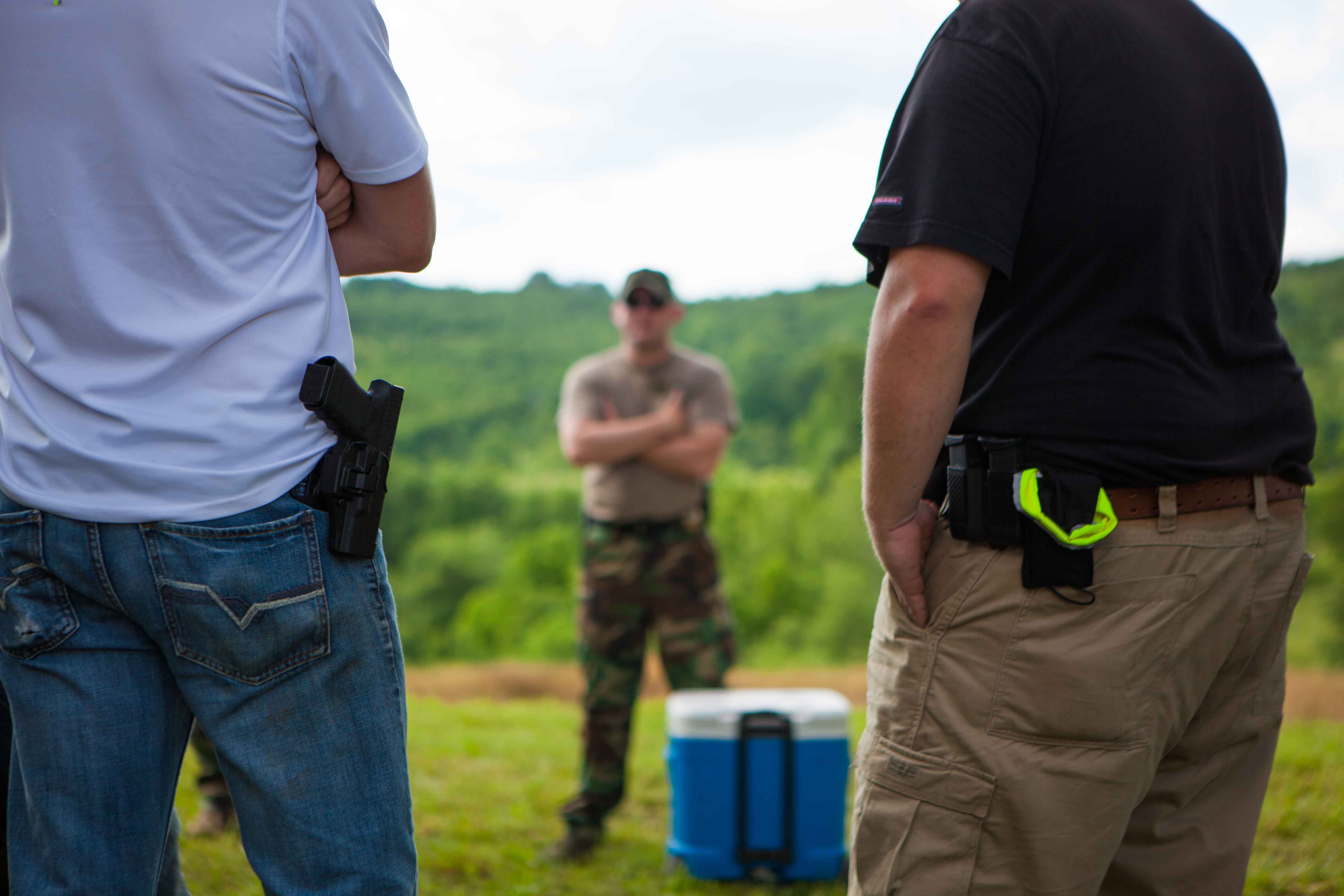
Hidden Pistols
Daisy says she can balance the roles of educator and gunfighter.
As an elementary school teacher, she’s used to giving students hugs. If she carries a concealed Glock on her torso, she plans to encourage fist bumps instead. They’re more age-appropriate for the older kids in her school, anyway.
Although Don and Greg say that women’s fashion can make it more difficult to conceal a pistol, Daisy is not worried. She has lost seventy pounds and has some oversized clothes that could help hide her secret. She probably wouldn’t wear the blue, tie-dyed peace sign T-shirt she wore during training.
Daisy has always loved kids. As a teenager, she baby-sat and worked at a day care. She has experience with special education.
Although she could be carrying a gun, she says teaching will be her focus.
She hopes to become so comfortable with the Glock that she can react without thinking if the need arises. She uses the analogy of defining a vocabulary word: knowing what it means and what to do—instantly.
As she finishes her lunch inside Shield’s classroom, she knows there’s work to be done on the range. After all, she’ll have to qualify in the morning, and there are problems to address. But she’s been practicing every night, dry-firing her gun, balancing an empty shell casing on the tip of the barrel to steady her aim and smooth out her trigger pulls. She’s improving, she says—better than she was four days ago.
Pass or Fail
Don and his team of instructors have taught many rookies how to shoot. Don says some of his best students have no prior experience with a pistol, so the instructors start with the basics: Grip. Stance. Sight alignment. Sight picture. Trigger press. He says the benefit is that rookies haven’t developed bad habits.
While the instructors are patient with novices, they must see progress. They also look for mental toughness, problem-solving ability, physical fitness, and, of course, weapons skills. Above all else, trainees must practice weapon safety. It helps if they don’t miss often. It helps further still if they don’t accidentally shoot an innocent target on the range.
Don and his crew have a nightly roundtable where they discuss the trainees and their progress. They use a simple majority to determine, hypothetically, if a trainee must go. Don says the vote is always unanimous.
The instructors know who’s improving and who’s struggling. They’re familiar with Daisy from the previous concealed-carry course she took with Shield. She has some work to do, but she hasn’t been voted off the island, yet.
A Test with Targets
“Both eyes,” Rob says to Daisy. “Remember. Both eyes.”
Daisy nods her head and smiles. Rob returns the smile, gives her a thumbs-up, and pats her on the shoulder.
The moment of truth has arrived: 9 am on the final day of training. No warm-up. From five distances, trainees will fire twenty rounds at an 18-by-32-inch cardboard target with a 12-by-24-inch fight-stopping region, the size of the average human torso and where the vital organs are located.
Five points are awarded for head shots and fight-stopping hits. Three points are awarded for any hits outside of that zone. Zero points for misses. Miss the target completely more than twice, and you fail. Miss the fight-stopping region more than five times and you fail. If you fail, you can try to qualify again twenty-four hours later. Fail again, and you could be permanently dismissed from the program.
The instructors talk to the students to loosen them up. For two of the instructors, it’s already been a long day. Hours earlier, around 3 am, Jason and Derek executed a raid with the Howell County Sheriff Department’s tactical team. They were serving a warrant on a suspected meth trailer.
The trainees fidget, massaging their hands, tracing the butts of ammo magazines with their fingers, swinging their arms to shake out the nerves. The press will watch from the sniper deck atop the hill behind the ranges; the distance is intended to alleviate some of the stress.
The trainees are split into two groups. Half go to Alpha Range, and Daisy and the other half go to Bravo where they will attempt to qualify. Daisy stands on the far right of the firing line.
The trainees will fire twice (once standing and once kneeling) from twenty-five yards. They’ll move up to the fifteen-yard line and fire eight rounds, then six rounds from the ten-yard line, and then two shots at both the five- and three-yard lines.
Qualification begins.
“On ‘gun,’ fire one round center mass, scan, and re-holster,” Derek says. He calmly and slowly repeats this statement before each of the twenty shots, lending a cadence to the proceedings.
From fifty yards away on the sniper deck, you can hear the pop of the Glocks and the PING! of hits. But you can’t tell who’s hitting what. What you can see is Daisy taking her time. She’s usually the last person to shoot.
Qualification ends.
Derek assesses each target at the front of the range, adding up the points.
Daisy walks over to the pop-up tent near the back of the range. She takes a pull from her water bottle and sits down in the shade, her knees tucked into her chest, her arms wrapped around them. She seems exhausted.
Derek calls her name. She stands up and walks over to the instructor. She reads off her gun’s serial number, so Derek can complete the paperwork.
She receives her score.
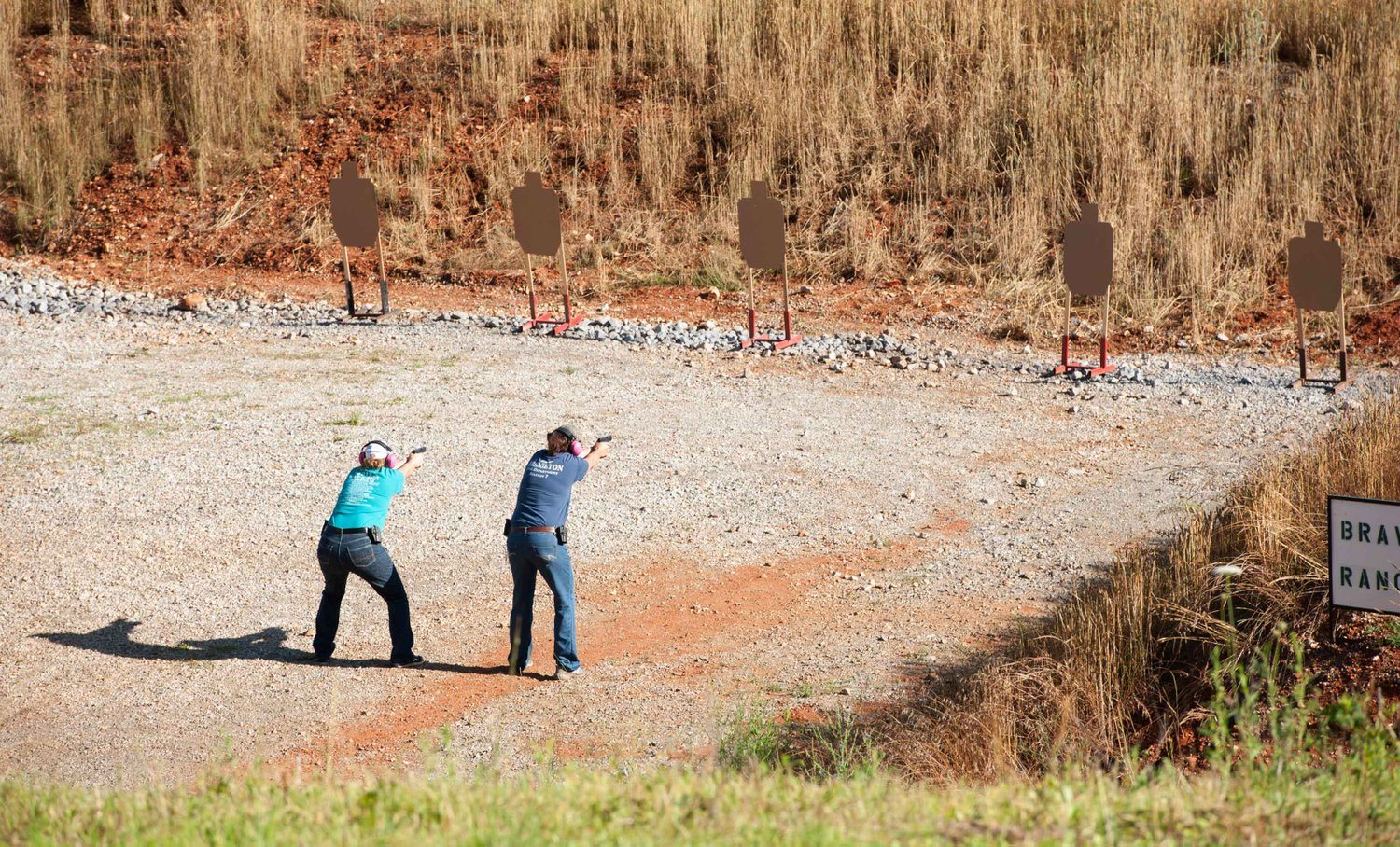
Aim Small, Miss Small
On the tactical range, the gallows and the saloon cast shadows in the early afternoon sun. Don Crowley sits with his left leg propped up on the fender of an ATV. He motions for me to come over. Our conversation is punctuated by gunfire as the educators run the tactical course, a timed individual exercise following qualification. It’s not a pass-or-fail test but demands integration of the skills they’ve learned.
Don finishes a cigarette and leans nearer to my ear. The lead instructor tells me there were three failing qualification scores—the first after the introductory week-long training session in the short history of Shield’s SEFTP. He can’t tell me who failed. I can’t help but wonder if Daisy is one of them.
Don and I finish our conversation and shake hands.
It’s Daisy’s turn to run the course now. She knows she’ll have a reporter on her tail, recording video for his story.
The buzzer sounds, and she’s off, popping up from her “desk,” an old cable spool, and engaging the targets. She runs through the course, zigzagging to different firing stations. It’s four-and-a-half minutes of heavy breathing.
At one point, she reloads, which she does smoothly. At another station, Fred surprises her, commanding a tactical reload, which she swiftly executes. Yes, there are some misses along the way but also many hits.
Don’t exceed your cover. Muzzle plus a foot. Sixty-forty grip. Front sight focus. Straight back.
She advances to the final firing station—the hostage shot. It’s a steel target like any other, except the bad guy has a captive, which is painted over his torso. A center-mass shot would hit the hostage. Instead, shoot the small black flap to the left of the bad guy’s head. After four minutes of shooting and running, Daisy must calm her breathing and steady her aim. “Aim small, miss small,” as the instructors say, half-mocking the line from the film The Patriot.
Keep both eyes open. Inch that trigger back. Pull slowly with the middle of your fingertip. Don’t anticipate the shot. Constant. Steady. Pressure. Control that trigger. BANG!
PING! A hit! Daisy finishes with a flair.
She re-holsters her gun and walks off the range.
The Secret Burden
A month after the training, Don told me he had shaved his beard for an interview with CBS. He also said that he’d been terminated from his post as police chief of Winona. Under advice from counsel, that’s all he could say. A representative from the Winona city council declined to comment.
Daisy and I spoke a few times by phone after we left West Plains. She failed her initial qualification on the last day of the course but said that she’d passed her second attempt the very next day. She shot an eighty-one the first time and a ninety-five the second. During our conversations, Daisy sounded motivated to start the school year as a Shield employee.
“This is serious now,” she said. “I want to be the best I can be safety-wise and with accuracy. I’m determined to do a good job.”
We fell out of touch in July, and she did not return my later phone calls. Later that month, I talked to Greg. I asked him how Daisy was doing. He told me she’d left the program. He hinted that the media attention—The Kansas City Star, CBS News, Missouri Life, all of it—made her reconsider. In an email to Missouri Life, she said that medical reasons caused her departure but that she would like to return to the program later.
Greg was disappointed that she left. He admired Daisy. She was improving, he said. She could do the job. He called her a “survivor.”
During one of my last phone conversations with Daisy, I asked her if she had any questions for me before I hung up. She did. What was my opinion, she wondered, of arming teachers? After seeing this training, what did I think?
And so, I told her.
Photos by Harry Katz and Stephanie Sidoti
Related Posts
Earthly Creations
They say that life is what happens while you’re busy making plans. We’re pretty sure you’d get no argument from Sandra Zak.
The Birdman of Salem
Artist David Plank can’t remember a time when he wasn’t drawn to birds. While his boyhood friends were busy kicking soccer balls and hitting baseballs, David was in the woods of Salem with paper and pencil, capturing the details of a perched barn swallow or a purple martin.

